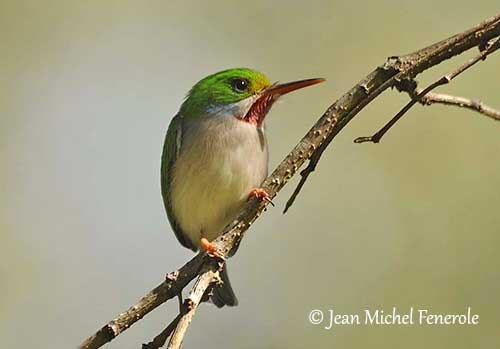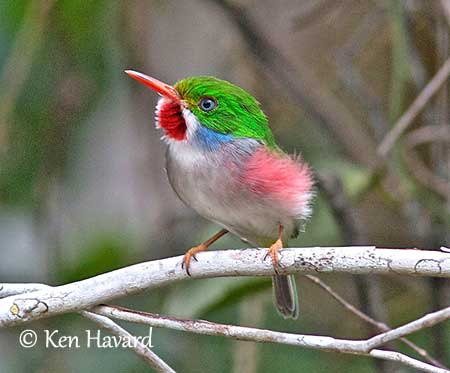Fr: Todier de Cuba
Ang: Cuban Tody
All: Vielfarbentodi
Esp: Barrancolí Cubano
Ita: Todo di Cuba
Nd: Cubaanse Todie
Sd: kubatodi
Photographers:
Jean Michel Fenerole
Photos d’Oiseaux du monde
Ken Havard
My Bird Gallery & Flickr gallery 1 & Flickr gallery 2
William Price
PBase-tereksandpiper & Flickr William Price
Text by Nicole Bouglouan
Sources:
HANDBOOK OF THE BIRDS OF THE WORLD Vol 6 by Josep del Hoyo-Andrew Elliott-Jordi Sargatal - Lynx Edicions, 2001 - ISBN: 848733430X
BIRDS OF THE WEST INDIES – by Herbert Raffaele, Kristin Williams et Tracy Pedersen – Helm – ISBN: 9780713649055
L’ENCYCLOPEDIE MONDIALE DES OISEAUX - Dr Christopher M. Perrins - BORDAS - ISBN: 2040185607
The Birds of Cuba – Cuban Tody
Neotropical Birds – Cornell Lab of Ornithology
Wikipedia, the free encyclopaedia
Arthur Grosset's Birds (Arthur Grosset)
Cuban Tody
Todus multicolor
Coraciiformes Order – Todidae Family
INTRODUCTION:
The family Todidae is confined to the Greater Antilles and includes five species. The genus Todus was split from kingfishers of genus Alcedo and established in 1760. However, the todies appear to be most closely related to the motmots, and especially the Tody Motmot (Hylomanes momotula), a small solitary bird of humid tropical and subtropical forests.
The Cuban Tody is the most brightly coloured member of the family. It is resident in Cuba and small adjacent islands. It is endemic to Cuba where it is widely distributed in forests and woodlands.
DESCRIPTION OF THE BIRD:
Biometrics:
Length: 10-11 cm
Weight: 4,3-8,5 g
The Cuban Tody adult has small body and relatively large head with broad, flat bill.
The upperparts are bright green, including head, wings and tail.
On the underparts, the belly is white, flanks are pink and undertail-coverts are yellow. On the underwing, the wing-coverts are yellowish-white.
On the green head, we can see a yellow-green supercilium. Lores are yellow. There is a pale blue patch on each side of the neck. Chin and throat are red, bordered by white malar stripe.
The broad, flat bill is black on the upper mandible and red below. The eyes are pale grey-blue. Legs and feet are dull reddish.
Male and female are similar.
The juvenile is duller with shorter bill, grey or pink throat, pale grey underparts and brown eyes. It lacks the pink on flanks and the blue and yellow patches on the head.
RANGE:
The Cuban Tody is endemic to Cuba, but it also occurs on the larger cays off the northern coasts (Coco, Romano, Guajaba, Sabinal, Saetia) and Isle of Pines.
The birds of Isle of Pines have deeper blue patch on the neck sides.
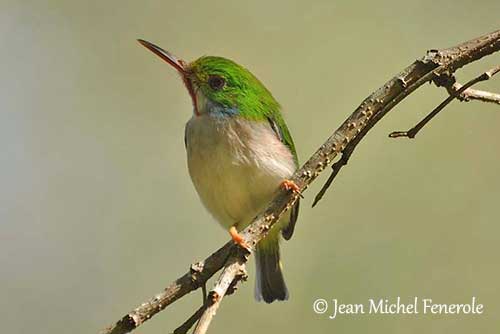
HABITAT:
The Cuban Tody frequents a variety of habitats, but it favours shaded areas close to streams and rivers. However, it is ecologically adaptable to the environment, and it can be found in wet thickets or woodlands, deciduous or pine forests and secondary vegetation. It also occurs on mountain slopes and in gullies. On Isle of Pines, it frequents the orchards.
The Cuban Tody is the only Todidae to inhabit shoreline habitats. It can be seen from sea-level up to 1974 metres of elevation in Pico Turquino.
CALLS AND SONGS: SOUNDS BY XENO-CANTO
The Cuban Tody utters repeated notes “tot-tot-tot-tot” when perched. The typical call of this species is a soft, clear, almost musical whistle “pprreeee-pprreeee”. In flight, the wings produce a mechanical noise.
BEHAVIOUR IN THE WILD:
The Cuban Tody feeds primarily on caterpillars, spiders and insects (adults and larvae). It may occasionally take small lizards, and it feeds rarely on small fruits.
The Cuban Tody searches for preys from a perch, and it usually appears rather inactive. But as soon as a prey is located, it flits up to catch it from twigs or undersides of leaves. It also catches insects in mid-air.
It is usually seen alone or in pairs. They hunt all day long, catching 1-2 insects / minute.
Like other todies, the Cuban Tody is monogamous. During the courtship displays, male and female can be seen chasing each other closely. Chases occur on straight flightpaths or in arcs or circles, weaving among low foliage over distances of up to 10 metres. Their wings produce a loud whirring sound, called “wing-rattling”. This sound can be compared to the noise produced while pulling one’s finger quickly across a comb. This sound was described in 1943 by T. Barbour for this species.
Prior to copulation, they also perform “flank-display”. During this display, the pink feathers of the flanks are fluffed. At the highest intensity of the display, the body appears completely inflated, with the bright pink tufts almost meeting over the back. Courtship feeding is reported too, usually following the chases. The copulation occurs when the female flaps her wings before to spread them, and raises her short tail.
Todies nests in excavated burrows and both mates take part in nest-building. The territory is defended against other todies.
The Cuban Tody is resident in Cuba.
During the flight, it produces a characteristic rattling with the wings. The short, rounded wings of this small bird are well-adapted to the short flightpaths, the small territories, and their usual behaviour and lifestyle.
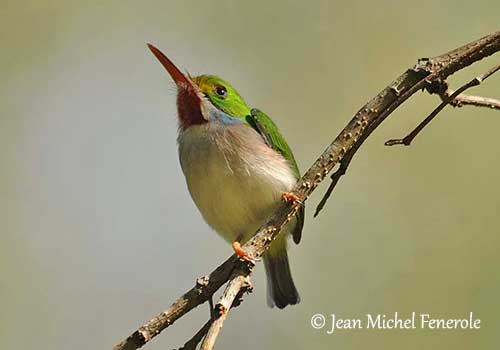
REPRODUCTION OF THIS SPECIES:
The breeding season takes place from March to April/June.
The Cuban Tody excavates a burrow/tunnel of about 30 centimetres long in earth bank, hollow tree trunk, tree cavity, or occasionally at cave entrance or in natural cavity. The nest-chamber is at the end, after some sharp turns to discourage the predators. The walls of the tunnel and nest-chamber are covered with a sticky mixture of grass, algae, feathers and lichens, and other materials acting as sealant.
The female lays 3-4 white eggs in the nest-chamber. The Cuban Tody has the smallest eggs of all todies. They are glossy and the shell is extremely fragile.
Both adults have a brood patch and share the incubation during about 3 weeks. The chicks are altricial. They are fed by both parents, mainly with insects. They fledge about 19-20 days after hatching. They remain in the vicinity of the burrow but never return to it even to sleep. The adults lead them to a nearby tree where they sleep at night, huddling close together on tiny branches. They depend on adults for food for 3 weeks after fledging.
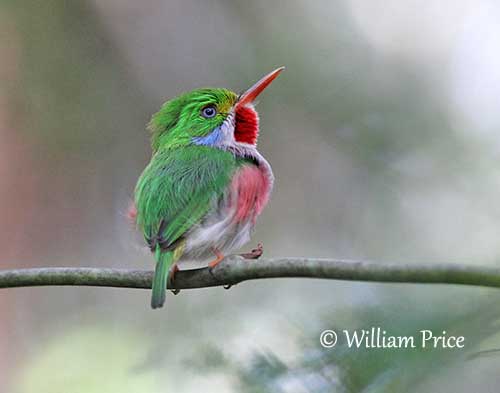
PROTECTION / THREATS / STATUS:
The Cuban Tody is widely distributed throughout the range in Cuba. The forest is protected, suggesting that populations are secure. However, aerial spraying and “fogging” of pesticides to control mosquito and sandflies’ populations could be a future threat.
But currently, the Cuban Tody is evaluated as least Concern.
